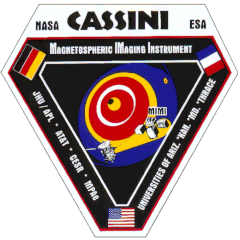Cassini MIMI Investigation at Fundamental Technologies
Historical MIMI Memos and Notes
Report on LEMMS Passband Design from T. P. Armstrong to Cassini MIMI Team, October 20, 1994
This memo covers the distribution to you of the results of calculations that I have recently made on the subject design. Highlights of the changes from the October 1993 version (and substantially recapitulated in March 1994) are the following:
- Detectors D1 and A have been changed in thickness from 100 microns to 150 microns so that standard Canberra detectors can be used. This also reduces the capacitances and makes the attainment of lower noise more secure. In several instances the passbands begin at slightly higher energy, but this disadvantage is offset by the technical simplification of using more trusted, standard detectors and having less capacitance-generated noise. Detector D1 will be the most susceptible to electron pile-up and its shaping time constants should be as short as reasonably attainable. The channel logic design takes account of the possibility of pile-up and uses the highest feasible thresholds to define the proton passbands.
- The electron range-energy table that PAMY uses has been revised to include only collisional energy loss and to exclude radiative energy loss. This should much more accurately estimate the energy deposition from high energy electrons in the LEMMS assembly. Before this change was made, the apparent energy losses of electrons were unrealistically high and electron responses were appearing in lower energy proton channels where they shouldn't be. As a consequence of this change in the range table for electrons, the logic for E5, E6, E7 has been revised. The new E5 is not as "nice" a channel as I would prefer. In fact, it is integral and duplicative and I would suggest dropping it. I suggest replacing it with different logic, called E0 in the tables here, that is a D1 singles-based channel for 100 to 180 keV electrons. Looking at the Voyager Saturn data, that is a very important and interesting part of the spectrum that is also covered by the deflected electron system. This will make a good cross-calibration for flight data.
- I have done a calculation of the expected response of the LEMMS 180 degree assembly to particles penetrating the stack from the 0 degree end (OBVERSE) to verify that we don't have trouble with bidirectionality.
- I have approximated the spectra of protons, electrons, helium, and oxygen for several positions in the Saturnian radiation zones and show estimated count rates.
I will fax an early and partial version of this memo to Livi and Kirsch at Lindau and Mitchell and Jaskulek at APL for their use in preparation for the Lindau team meeting. I will distribute it in full and comment on it at the team meeting.
- Voyager LECP Electron Spectra at Equal (B,L)
- LECP on Voyager 2
- Voyager LECP Ion Spectra at Equal (B,L)
- MIMI LEMMS Geometry
- MIMI LEMMS vs. Voyager Spectra, part 1
- MIMI LEMMS vs. Voyager Spectra, part 2
- MIMI LEMMS vs. Voyager Spectra, part 3
- MIMI LEMMS vs. Voyager Spectra, part 4
- MIMI LEMMS vs. Voyager Spectra, part 5
- MIMI LEMMS vs. Voyager Spectra, part 6
- MIMI LEMMS vs. Voyager Spectra, part 7
- MIMI LEMMS vs. Voyager Spectra, part 8
- MIMI LEMMS vs. Voyager Spectra, part 9
- MIMI LEMMS vs. Voyager Spectra, part 10
- LEMMS 0 Degree Electron and Proton Passbands
- MIMI 180 Degree Electron and Proton Passbands
- MIMI 0 Degree Oxygen, Electron, Proton, and Helium Passbands
- MIMI 180 Degree Helium, Proton, Electron, and Oxygen Passbands
- MIMI LEMMS 0 Degree End Passband Summary, Oct. 5, 1994, Version
- MIMI LEMMS 180 Degree End (Obverse) Passband Summary, Oct. 6, 1994, Version
- Cassini MIMI LEMMS 0 Degree End (Bidirectional 180 Degree Channels), Oct. 5, 1994
- MIMI 150 Energy Loss vs. Incident Energy - 5 plots
- MIMI 150 Delta E vs. E - 4 plots
- Incident Energy MeV/Nuc, Efficiency for Electrons - 4 plots
- Incident Energy MeV/Nuc, Efficiency for Protons - 2 plots
- Incident Energy MeV/Nuc, Efficiency for Helium 4 - 2 plots
- Incident Energy MeV/Nuc, Efficiency for Carbon 12
- Incident Energy MeV/Nuc, Efficiency for Oxygen 16
- Incident Energy MeV/Nuc, Efficiency for Iron 56
- Incident Energy MeV/Nuc, Efficiency for Protons - 4 plots
- Incident Energy MeV/Nuc, Efficiency for Helium 4 - 3 plots
- Incident Energy MeV/Nuc, Efficiency for Oxygen 16
- Incident Energy MeV/Nuc, Efficiency for Iron 56
Return to Historical MIMI Notes and Memos main page.
Return to Cassini
MIMI table of contents page.
Return to Fundamental
Technologies Home Page.
Updated 8/8/19, Cameron Crane
QUICK FACTS
Mission Duration: The Cassini-Huygens mission launched on October 15 1997, and ended on September 15 2017.
Destination: Cassini's destination was Saturn and its moons. The destination of the Huygens Probe's was Saturn's moon Titan.
Orbit: Cassini orbited Saturn for 13 years before diving between its rings and colliding with the planet on September 15th, 2017.



